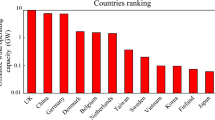Abstract
In this study, a novel procedure to estimate the metacentric height (GM) is proposed based on an autoregressive modeling procedure and a self-organizing state space modeling with respect to the onboard monitoring of roll data. First, the autoregressive modeling procedure is applied to estimate a natural frequency of the roll motion. Subsequently, a self-organizing state space modeling procedure is applied to estimate the GM using the estimated natural frequency. Model and onboard experiments were performed to verify the proposed procedure. The results confirmed that the proposed procedure achieves a good estimation in which the estimated results are in agreement with those obtained in the model experiments and are close to those derived from the stability manual corresponding to the ship condition in onboard experiments.













Similar content being viewed by others
References
Bradley MS, Macfarlane CJ (1986) The in-service measurement of hydrostatic stability. Offshore Technology congress, Paper 5345 (1986). https://doi.org/10.4043/5345-MS
Brown TD, Witz JA (1996) Estimation of vessel stability at sea using roll motion records. Trans R Inst Naval Archit 130:130–146
Ohtsu K (2008) Statistical analysis and control of ship’s motion—review and prospect of the studies for 40 years (in Japanese). J Tokyo Univ Mar Sci Technol 4:37–48
Míguez-González M, Caamaño-Sobrino P, Tedín-Álvarez R, Díaz-Casás V, Martínez-López A, López-Peña F (2012) Fishing vessel stability assessment system. Ocean Eng 41:67–78
Huss M, Olander A (1994) Theoretical sea-keeping predictions on-board ship—a system for operational guidance and real time surveillance, Report ISRN KTH/FKT/SKP/FR-94/50-SE. KTH, Sweden
Míguez–González M, Díaz–Casás V, Caamaño–Santiago L (2016) Real–time stability assessment in mid-sized fishing vessels. In: Proceedings of the 15th International Ship Stability Workshop, pp 201–208
Iseki T, Baba M, Hirayama K (2013) Hybrid bayesian wave estimation for actual merchant vessels. In: Neumann T (ed) Marine navigation and safety of sea transportation, pp 293–298
Hirayama T (2015) Historical review on the development of measurement technologies for actual ships—mainly on the ship research association of Japan (in Japanese). Textbook of the Marine Dynamics Symposium “Ship Performance Monitoring in Actual Seas”, pp 39–73 (2015)
Cooley W, Tukey JW (1965) An algorithm for the machine calculation of complex Fourier series. Math Comput 19:297–301
Akaike H (1969) Power spectrum estimation through autoregressive model fitting. Ann Inst Stat Math 21(3):407–419
Akaike H (1973) Information theory and an extension of the maximum likelihood principle. In: Petrov BN, Caski F (eds) Proceedings of the 2nd International Symposium on Information Theory. Akadimiai Kiado, Budapest, pp 267–281
Yamanouchi Y (1956) On the analysis of ships—oscillations as a time series (in Japanese). J Zosen Kyokai 99:47–64
Ohtsu K, Kitagawa G (1989) Full scale data depended statistical estimate of the parameters in the equation of ship’s oscillation application of a continuous auto regressive model (in Japanese). J SNAJ 1989(165):181–191
Iseki T, Ohtsu K (1999) On-line Identification of the Ship Motion Parameters (in Japanese). J SNAJ 1999(186):107–113
Terada D, Kitagawa G (2009) Direct estimation method for the ship motion parameters based on time series analysis—verification based on one degree of freedom model (in Japanese). J JASNAOE 9:127–137
Terada D, Hashimoto H, Matsuda A (2016) Estimation of parameters in the linear stochastic dynamical system driven by colored noise sequence. In: Proceedings of the ISCIE International Symposium on Stochastic Systems Theory and its applications, pp 125–131
Kitagawa G (1998) A self-organizing state space model. J Am Stat Assoc 93(443):1203–1215
Kitagawa G (1996) Monte Carlo filter and smoother for non-Gaussian nonlinear state space model. J Comput Graph Stat 5(1):1–25
Kitagawa G (1993) A Monte Carlo filtering and smoothing method for non-Gaussian nonlinear state space models. In: Proceedings of the 2nd US–Japan Joint Seminar on Statistical Time Series Analysis, pp 110–131
Gordon NJ, Salmond DJ, Smith AFM (1993) Novel approach to nonlinear/non-Gaussian Bayesian state estimation. IEE Proc F Radar Signal Process 140(2):107–113
Kitagawa G (2010) Introduction to Time Series Modeling. Chapman and Hall/CRC, Boca Raton, pp 105–106
Ypma TJ (1995) Historical development of the Newton–Raphson method. SIAM review 37(4):531–551
Kobylin L, Kastner S (2003) Stability and safety of ships, vol 1: regualation and operation. Elsevier, Oxford, p 89
Kitagawa G, Gersch W (1984) A smoothness priors-state space modeling of time series with trend and seasonality. J Am Stat Assoc 79:378–389
(2016) http://nrife.fra.affrc.go.jp/plant/kaiyou/kaiyou_e.html. Accessed 1 Sept 2017
ITTC (2008) Recommended procedures, model tests on intact stability, 7.5–02–07–04
World Meteorological Organization (1995) Manual on codes international codes, Vol. I.1, WMO–No. 306
ITTC (1963) Report of Seakeeping Committee, Proceedings of 10th ITTC. London
ITTC (1984) Report of Seakeeping Committee, Proceedings of 17th ITTC. Göteborg
Umeda N, Yamakoshi Y (1993) Measurement of directional irregular waves generated in a square basin with side-wall veflections (in Japanese). J SNAJ 174:297–307
Umeda N, Usada S, Mizumoto K, Matsuda A (2016) Broaching probability for a ship in irregular stern–quatering waves: theoretical prediction and experimental validation. JMST 21(1):23–37
http://www.data.jma.go.jp/fcd/yoho/hibiten/index.html. Accessed 1 Sept 2017
Acknowledgements
This work was supported by the commissioned project for R&D of marine science and technology of Nagasaki Industrial Promotion Foundation. Authors would like to thank all affiliated parties. Moreover, the authors would like to thank Enago (http://www.enago.jp) for the English language review.
Author information
Authors and Affiliations
Corresponding author
About this article
Cite this article
Terada, D., Tamashima, M., Nakao, I. et al. Estimation of metacentric height using onboard monitoring roll data based on time series analysis. J Mar Sci Technol 24, 285–296 (2019). https://doi.org/10.1007/s00773-018-0552-4
Received:
Accepted:
Published:
Issue Date:
DOI: https://doi.org/10.1007/s00773-018-0552-4




